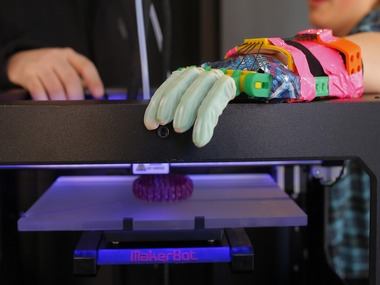If you thought 3D printing was impressive, be amazed because the fourth dimension is here. Four-dimensional or 4D printing technology allows for creation of complex, shape-shifting structures. This technology, developed by researchers at the Georgia Institute of Technology and the Singapore University of Technology and Design (SUTD), can be used to create 3D structures that sequentially fold themselves from components that had been flat or rolled into a tube. The components can be triggered to change shape by responding to various stimuli such as temperature, moisture or light in a way that is precisely timed to create space structures, deployable medical devices, robots, toys and range of other structures. Smart shape memory polymers (SMPs) with the ability to remember one shape and change to another programmed shape when uniform heat is applied were used by researchers. [caption id=“attachment_1994769” align=“alignleft” width=“380”]  Representational image: Reuters[/caption] Printing multiple materials with different dynamic mechanical properties in prescribed patterns throughout the 3D object gives it the ability to change shape in a controlled manner over time. When these components are then heated, each SMP responds at a different rate to change its shape, depending on its own internal clock. By carefully timing these changes, 3-D objects can be programmed to self-assemble. The research creates self-folding structures from 3-D printed patterns containing varying amounts of different smart shape-memory polymers. The patterning, done with a 3-D printer, allows the resulting flat components to have varying temporal response to the same stimuli. As Jerry Qi, a professor in the George W Woodruff School of Mechanical Engineering at Georgia Tech explains, earlier approach to the methodology involved application of controlled heat over various parts of the component but that was highly complicated. Here, a spatially uniform temperature is used, which is easier to apply and manipulated to rate of shape change of various materials. The applications of this technology can be something as simple as easing the transport of objects - that can be rolled up or folded on the move and then made to get to its original shape for use. Or, it can be something as complex as an unmanned air vehicle turning into one that can dive into water and still work. 4D printing technology is expected to be commercialized in 2019 according to a Research and Markets report. The global 4D printing market is expected to grow at a CAGR of 42.95% between 2019 and 2025. The market is segmented on the basis of material segments into programmable carbon fiber, programmable wood grain, and programmable textiles. The programmable carbon fiber segment is expected to be the largest contributor to the overall market, with a share of -62% of the market, in 2019. With inputs from PTI
If you thought 3D printing was impressive, be amazed because the fourth dimension is here. Four-dimensional or 4D printing technology allows for creation of complex, shape-shifting structures.
Advertisement
End of Article


)

)
)
)
)
)
)
)
)



